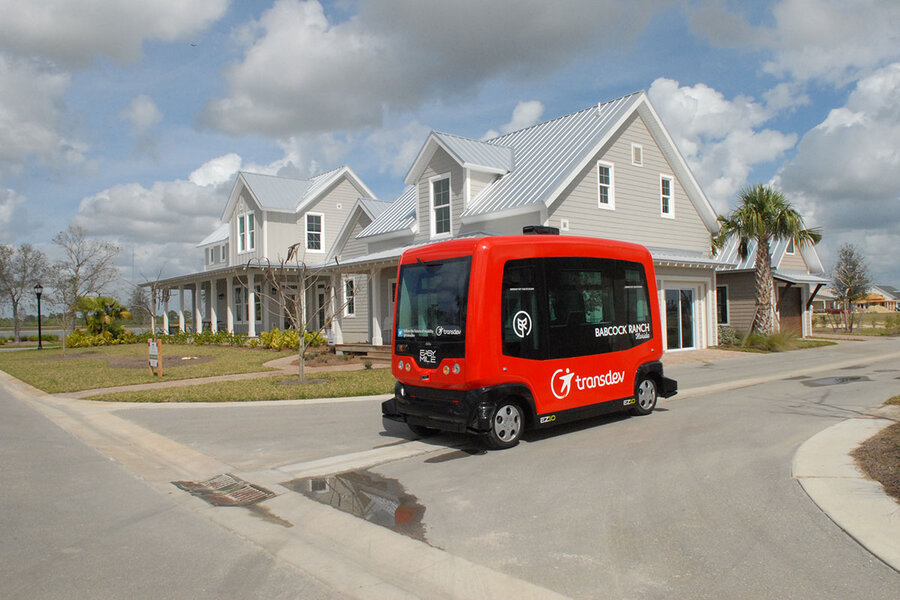In the Sunshine State, a vision for a sustainable town
Loading...
| Babcock Ranch, Fla.
Children play in a fountain as their parents watch from the shade of a palm tree. Friendly chatter emanates from a nearby restaurant. Downtown Babcock Ranch, Fla., seems much like the center of any other small town.
And yet green-stemmed solar “trees” dot the landscape. A driverless red pod buzzes down the street. And the old-timey general store is powered by the sun.
Babcock Ranch may resemble the towns of the past, but developer Syd Kitson built the community for a sustainable future. This marriage of conventional development and eco-friendly innovation offers a more traditional model of sustainability. Many green urban planners remain skeptical that this experiment in sustainable living will be able to achieve the kind of eco-haven that Mr. Kitson is proposing. But for some, Babcock Ranch is a step in the right direction.
“We wanted to prove that environmental responsibility can go hand-in-hand with development,” Kitson says.
Babcock Ranch, which currently looks like a town center protruding from an otherwise empty prairie, held its official grand opening March 10 but it has yet to incorporate. The plan is for some 19,500 homes to be constructed, but today there are just a handful, and only a few of those are occupied. The rest of the lots are filled with sparse grass and fire ants, awaiting backhoes.
But the town square is already active, with the restaurant, general store, and ice cream shop seeing new customers daily. Kitson estimates that curiosity has brought about 1,000 visitors a week.
“I think we’ve struck a chord with people," Kitson says. “And that’s starting to translate into people wanting to live here.”
Curbing cars
The most visible of the town’s sustainability efforts are the encouragements to drive less. Although just one electric-powered, self-driving shuttle navigates the streets on a trial basis now, the plan is for a fleet of the red pods to follow set routes and be summonable via smartphone. The town was also designed with walkability in mind, with residential streets all within walking distance from the town square. Bike shares offer another transportation option.
Steve Wheeler, a professor in the landscape-architecture program of the department of human ecology at University of California, Davis, doubts that Babcock Ranch will be able to get people to completely eliminate their cars.
“One basic problem is location,” he says. With the nearest city, Fort Myers, about 15 miles away, people will still travel outside of the town for their jobs and other resources, despite the fiber-optic internet service and coworking space in the town center.
For this reason, cities have often been held up as having the smallest environmental footprint. Urban-dwellers share resources, drive less, and take up less land.
So, Wheeler says of Babcock Ranch, “It will be a model of moderately better suburban development. I hand it to the developers for trying to improve on conventional models.” But he suggests building eco-friendly communities onto existing urban centers might be be the best way to develop sustainably.
But, says Steve French, dean of the College of Design and a professor of City and Regional Planning at Georgia Institute of Technology, “Not everybody wants to live in Manhattan-scale density. So I think sustainability principles have got to be applied to suburban kinds of situations.”
Powering a city
Historically, so-called eco-cities have aspired to be independent from the utility grid, something that utility companies have fought. But Babcock Ranch works within the system, drawing power primarily from Florida Power & Light's 75-megawatt solar farm, to which Kitson donated 440 acres. The city also supplements this power with small installations like the solar trees.
“It is somewhat realistic in that it does tie into the existing grid and works with the existing utility,” says David Hsu, assistant professor of urban and environmental planning at the Massachusetts Institute of Technology.
Solar panels work only when the sun shines. When it’s cloudy or nighttime, Babcock Ranch draws its power from the utility’s conventional sources. In Florida, most electricity is generated from natural gas.
The town could further reduce its dependence on fossil fuels, as Florida Power & Light announced March 9 that it is beginning to install batteries at the Babcock Ranch solar field.
Making sustainability a habit
Kitson’s vision was also to build sustainability into the infrastructure. That meant requiring home-builders to install efficient windows and insulation, efficient heating and cooling systems, and energy and water saving appliances. All houses built in the community must achieve no less than a Bronze rating from the Florida Green Building Certification.
Irrigation is done with recycled water, and community gardens are sustained with collected rainwater. Landscaping around town predominantly uses native plants that are adapted to survive mainly off the amount of rain that falls in the region.
The curriculum at Babcock Neighborhood School, which opened in the fall of 2017 as a public charter school open to surrounding communities, focuses on instilling sustainability and conservation principles through project-based learning, too.
It’s this mentality that attracted the Vokaty family. Kelli da Silva Vokaty and her husband and two daughters originally had no plans to move from their home in Pembroke Pines, Fla. But when Mrs. Vokaty saw a television report about “the first solar-powered town in America,” the family made plans to check it out. Less than a week later, the Vokatys were sold on Kitson’s vision, and had put a down payment on one of the model houses there, with plans to move in two years.
Vokaty says she had a lifelong love for nature, and hopes to further instill eco-friendly habits in her children. “I want them to make a difference for their generation,” she says.







